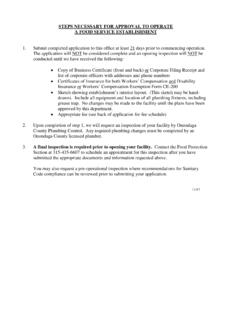Transcription of Ensuring Privacy and Security of Health Information ...
1 Ensuring Privacy and Security of Health Information Exchange in Pennsylvania 2014 Ensuring Privacy and Security of Health Information Exchange in Pennsylvania Privacy and Security White Paper Page 2 Copyright PAeHI, 2014 Contents Executive Key Concepts, Personal Health Key Landscape and Roadmap Current and United States National Benchmarks from National Efforts and Other What Is Currently Required?..17 Policies: Legal, Regulatory, Organizational, and Conforming to Policies and Controlling Workforce Enabling the Best Stakeholder Key Technical Demonstration and Model Emerging Areas of Risk and New Compliance Cloud Hosting Cyber Security Insurance and Cyber Attacks Mobile Device Management (BYOD) Physician and Patient Portals Checkbox Compliance Convergence of HIOs and Social Media Disposal of PHI PHI Ownership and Proprietary EHRs/HIEs Business Intelligence and Data Analytics Backup and Disaster Recovery for HIOs Addressing Barriers to Federal 2011 AMA Sample Pennsylvania Opt-Out Ensuring Privacy and Security of Health Information Exchange in PA, Slides from May 14, 2014 PAeHI Acknowledgements & and Security White Paper Page 3 Copyright PAeHI, 2014 Introduction The Pennsylvania eHealth Initiative (PAeHI) is a not-for-profit founded in 2005 by the state s leading Health care organizations to transform Health care by fostering the broader adoption of electronic Health records and Health Information exchange.
2 In the sharing of patient data, PAeHI recognizes that robust patient Privacy and Security protections are essential to build and maintain the necessary level of trust among patients, Health care providers, Health plans, and other stakeholders. PAeHI also believes that a balance must be maintained between the protection of patient Privacy and the adequate and timely sharing of patient data at the point of care. This white paper addresses Health care data Privacy and Security for electronic Information exchange. The key purpose is to help Health care providers achieve acceptable data Privacy and Security assurance for Health care consumers, while minimizing cost and confusion. It does not discuss the much broader issues of non-electronic Health care data Privacy or general Security technology.
3 The regulatory and marketplace landscape has been evolving in a dramatic fashion since the first edition of this white paper in 2009. In order to set that stage, the legal and regulatory sections have been made more in depth to serve as a tool for the provider community. Pennsylvania has also established an independent Commonwealth agency that has been tasked with governing the state Health Information exchange network of services, establishing and maintaining a common consent registry for patients to opt-out of the exchange, and promoting interoperability within the state HIE marketplace. Much of the updated material in this white paper is reflective of that effort, and is offered here as guidance to the Health care community at large. Ensuring Privacy and Security of Health Information Exchange in Pennsylvania Privacy and Security White Paper Page 4 Copyright PAeHI, 2014 Executive Summary Patients are unlikely to share sensitive Health Information unless they are confident that their provider will honor their confidentiality.
4 Similarly, Health care entities are unlikely to join a Health Information exchange if they are not confident that their medical records will be kept safe and that the data will be flowing securely. A key factor in achieving a high level of trust and compliance among individuals, Health care providers, and other Health care organizations participating in a Health Information exchange is the development of, and adherence to, a consistent and coordinated approach to Privacy and Security . Clear, understandable and uniform principles are a first step in developing this approach to Privacy and Security while building trust, which are all essential to the realization of the considerable benefits of HIE. It can be a challenge to adopt clear and uniform Privacy and Security principles in a legal landscape that seems inconsistent and restrictive.
5 Absorbing those principles into a sustainable business model that hits all its required regulatory marks requires strong leadership and the will to get it done to both support the business goals and serve the patients and consumers of Pennsylvania. In 2012, the Commonwealth established the Pennsylvania eHealth Partnership Authority as the governance entity for HIE in the state. The Authority is moving forward with all the mandates contained in its founding legislation to provide uniform standards and agreements that are produced in concert with stakeholders, along with freely distributed consumer outreach tools and a state consent registry. PAeHI sees this as the first vital step in Pennsylvania achieving a truly interoperable Health Information exchange network that both supports and expands the market for such services.
6 The broad topic discussions and outlines contained in this white paper are presented as a tool to spur further thinking about the appropriate methods to interface with the legal requirements as to electronic Health Information Privacy and Security , the specific requirements within Pennsylvania, and the workplace challenges of technical and administrative implementation. Ensuring Privacy and Security of Health Information Exchange in Pennsylvania Privacy and Security White Paper Page 5 Copyright PAeHI, 2014 Key Definitions Concepts Privacy (1) The right to have all records and Information pertaining to Health care treated as confidential. (2) Freedom from intrusion into the private life or affairs of an individual when that intrusion results from undue, unauthorized, or illegal gathering and use of data about that individual.
7 (HIMSS, 2006) Security The means to control access and availability, and to protect Information from accidental or intentional disclosure to unauthorized persons and from alteration, destruction, or loss. The concepts of confidentiality, integrity, authenticity, and accountability are included in Security . HITECH Act Title XIII ( Health Information Technology), Division A, pp 112-165 and Division B, pp 353-398 of ARRA may be cited as the " Health Information Technology for Economic and Clinical Health Act" or the "HITECH Act." Omnibus Final Rules The Omnibus final rule clarifications were released in January 2013 to provide additional rulemaking around the HIPAA Privacy and Security Rules. The Omnibus rule was based on statutory changes under the HITECH Act and the Genetic Information Nondiscrimination Act of 2008 (GINA).
8 Meaningful Use A concept included in the HITECH Act that allows for incentive payments to providers for the deployment and appropriate use of electronic Health records. Pennsylvania eHealth Information Technology Act This Act, also known as Act 121 of 2012, established the Pennsylvania eHealth Partnership Authority (Authority) as an independent agency of the Commonwealth and the governance body for the statewide technological Health Information exchange network it was to build. Stakeholders Consumer A person who obtains Health care services or, by extension, a person who represents a patient such as a parent or legal guardian. Ensuring Privacy and Security of Health Information Exchange in Pennsylvania Privacy and Security White Paper Page 6 Copyright PAeHI, 2014 Covered Entity (CE) HIPAA defines covered entities as Health plans, Health care clearinghouses, and Health care providers who electronically transmit any Health Information in connection with transactions for which HHS has adopted standards.
9 These transactions are usually billing and payment for services or insurance coverage. An entity may be a hybrid entity that performs both covered and noncovered functions. The HIPAA Privacy Rule only applies to Covered Entities. Patient The direct recipient of Health care and the subject of associated Health care records. Health plan An entity that provides financial reimbursement to providers for their services to consumers and, in some cases, determines what and how much care will be reimbursed and how much consumers must pay. HIE Health Information exchange. This may be a mechanism or organization designed to share Health care Information electronically across organizations within a region or community, or it may be the technological act of sharing such electronic Information .
10 HIO Health Information organization. A Health Information technology infrastructure or the organization establishing such a system to ensure the secure digital exchange of Health Information among participants engaged in the care of patients. Provider Any person or entity that supplies Health care services for patients. Stakeholder A general term which includes consumers, patients, Health plans, HIEs, HIOs, providers, vendors, and government. Personal Health Information EHR A longitudinal Electronic Health Record compiled from clinical data supplied by multiple care providers. It may be a single record or a series of records linked by a common patient identity. EHRs may be connected in an interoperable fashion with other records systems. EHRs are expected under Meaningful Use requirements.

